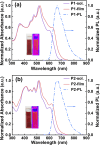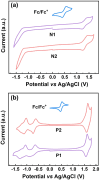Ambipolar conjugated ladder polymers by room-temperature Knoevenagel polymerization
- PMID: 39055013
- PMCID: PMC11268504
- DOI: 10.1039/d4sc03222e
Ambipolar conjugated ladder polymers by room-temperature Knoevenagel polymerization
Abstract
Two soluble conjugated ladder polymers (cLPs), decorated with multiple electron-poor species (i.e., cyano groups, fused pentagons, and N-heterocyclic rings), have been synthesized from the newly developed tetraketo-functionalized double aza[5]helicene building blocks using a single-step Knoevenagel polycondensation strategy. This facile approach features mild conditions (e.g., room temperature) and high efficiency, allowing us to quickly access a nonalternant ladder-like conjugated system with the in situ formation of multicyano substituents in the backbone. Analysis by 1H NMR, FT-Raman, and FT-IR spectra confirms the successful synthesis of the resulting cLPs. The combination of theoretical calculations and experimental characterizations reveals that the slightly contorted geometry coupled with a random assignment of trans- and cis-isomeric repeating units in each main chain contributes to improving the solubility of such rigid, multicyano nanoribbon systems. Apart from outstanding thermal stability, the resulting cLPs exhibit attractive red fluorescence, excellent redox properties, and strong π-π interactions coupled with orderly face-on packing in their thin-film states. They are proven to be the first example of ambipolar cLPs that show satisfactory hole and electron mobilities of up to 0.01 and 0.01 cm2 V-1 s-1, respectively. As we demonstrate, the Knoevenagel polycondensation chemistries open a new window to create complex and unique ladder-like nanoribbon systems under mild reaction conditions that are otherwise challenging to achieve.
This journal is © The Royal Society of Chemistry.
Conflict of interest statement
The authors declare no conflict of interest.
Figures







Similar articles
-
Fully conjugated ladder polymers.Chem Sci. 2017 Apr 1;8(4):2503-2521. doi: 10.1039/c7sc00154a. Epub 2017 Feb 17. Chem Sci. 2017. PMID: 28553483 Free PMC article.
-
The Chemistry and Applications of Heteroisoindigo Units as Enabling Links for Semiconducting Materials.Acc Chem Res. 2020 Dec 15;53(12):2855-2868. doi: 10.1021/acs.accounts.0c00480. Epub 2020 Nov 17. Acc Chem Res. 2020. PMID: 33201668
-
The Influence of Interlocking Effects in Conjugated Polymers Synthesized by Aldol Polycondensation on Field-Effect Transistor Properties and Morphology.JACS Au. 2025 Feb 27;5(3):1382-1391. doi: 10.1021/jacsau.5c00003. eCollection 2025 Mar 24. JACS Au. 2025. PMID: 40151251 Free PMC article.
-
Secondary Structure in Nonpeptidic Supramolecular Block Copolymers.Acc Chem Res. 2021 May 18;54(10):2397-2408. doi: 10.1021/acs.accounts.1c00028. Epub 2021 Apr 29. Acc Chem Res. 2021. PMID: 33914498 Review.
-
Conformation Control of Conjugated Polymers.Chemistry. 2020 Dec 9;26(69):16194-16205. doi: 10.1002/chem.202000220. Epub 2020 Sep 23. Chemistry. 2020. PMID: 32346938 Review.
References
-
- Yang J. S. J. Fang L. Chem. 2024;10:1–57.
LinkOut - more resources
Full Text Sources
Research Materials
Miscellaneous

